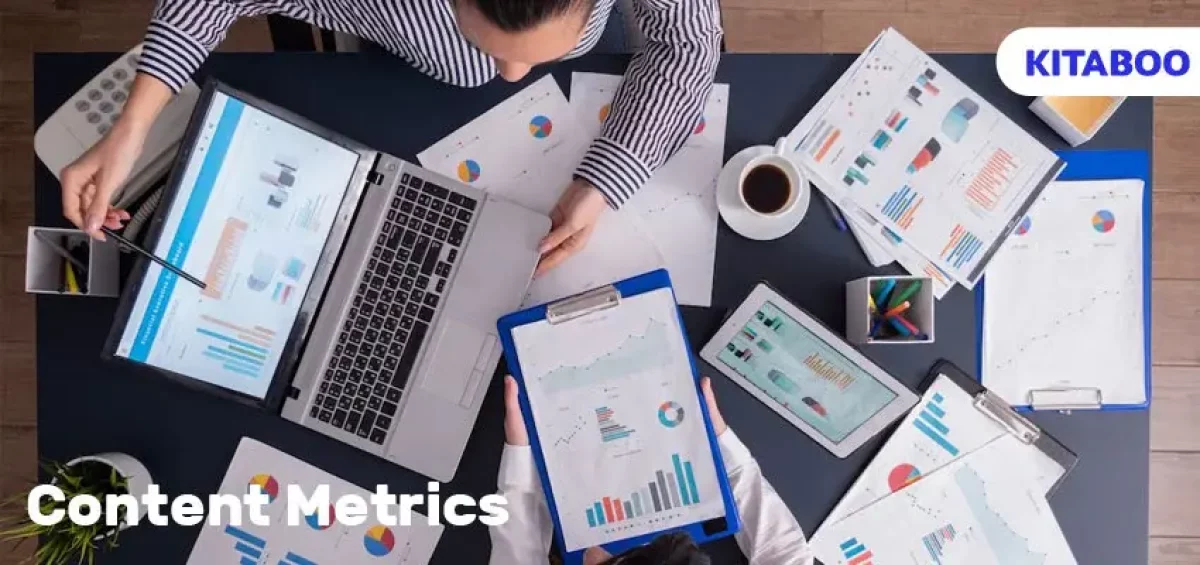Quality content drives user interaction, encourages meaningful engagement, and attracts the right kind of attention. In this regard, it is critical for editors to measure the success of content using key metrics like conversion rates or website traffic to assess its effectiveness and achieve organizational goals.
Alliance with robust digital textbook platforms like KITABOO, in this context, can help editors and leaders of various organizations devise, design, implement, and distribute content across multiple channels. It also provides insightful analytics and reporting tools to track the performance of content.
In this post, we cover some key content metrics that can help editors assess and enhance the impact of their content. Read on!
Table of Contents:
I. Tips for Editors to Enhance Content Success
- Create Content According to the Needs of the Audience
- Create Attention-Grabbing Content That Represents the Brand Value
- Promote SEO-Enriched Content
- Share Content Across Social Media Platforms
II. Top KPIs and Content Metrics That Help in Assessing the Success of Content Formation
III. Conclusion
Tips for Editors to Enhance Content Success
Editors and general managers of an organization need to ensure that content formation should meet the needs and expectations of the audience.
Especially when it comes to the K12 sector, editors need to tailor content to engage and educate students effectively. This way, the educational content becomes more impactful and contributes significantly to the learning experience.
Here are some tips that help editors enhance their content success:
Create Content According to the Needs of the Audience
It is important to establish clear objectives and conduct thorough audience research to understand the demographics, preferences, and interests of the target audience. It is important to personalize content to meet their needs and expectations, which will ultimately drive engagement and generate leads.
In the K12 sector, creating content that resonates with the needs of the audience is crucial for effective education. To do this, editors in the K12 sector should follow a strategic approach that takes into account the unique characteristics of their audience.
Create Attention-Grabbing Content That Represents the Brand Value
When it comes to content creation, you must have professionals help you create compelling titles, headlines, body structure, and intriguing construction that prioritizes quality over quantity. It should be informative enough to build audience trust.
In the K12 sectors, editors can leverage digital textbook platforms like KITABOO to not only engage students but also represent the brand values effectively. It also provides an innovative and interactive environment for educational content.
Promote SEO-Enriched Content
High-quality content helps search engines identify your brand if you implement SEO best practices. You must use descriptive tags, optimize links, and highlight relevant keywords to rank your content high on search engines.
Use multimedia, like images, infographics, and videos, to enhance the visual appeal and engagement of the content. This is particularly beneficial when it comes to the K12 sector, as it not only enhances visibility but also makes the educational material more appealing to students.
Share Content Across Social Media Platforms
It is important to enhance reach and engagement by leveraging social media platforms. It is important to optimize posts for each platform and develop a content calendar to plan and engage with the audience through comments and discussions.
This helps maintain consistency, align content with key events, and avoid gaps in publishing. Further cross-channel sharing encourages readers to share content with their networks.
Top KPIs and Content Metrics That Help in Assessing the Success of Content Formation
Here are some of the key metrics that can help editors and general managers assess the success of content:
Audience Feedback
Make sure you act on feedback received from the audience. Consider comments, social media interactions, and user surveys to improve content and address audience preferences iteratively. This includes:
- Customer Lifetime Value (CLV) which should be tracked through content to understand the long-term value generated
- Brand Loyalty and Advocacy resulting from the content, as seen through ongoing engagement and positive sentiment.
- Evergreen Content Performance that provides sustained value and traffic.
- Benchmark Against Industry Standards helps in comparing the content’s performance against industry benchmarks to understand how it fares in the broader landscape.
It is highly recommended to partner with KITABOO, a unique digital textbook platform and a cloud-based interactive platform that can help organizations create, publish, and distribute interactive multimedia-rich and mobile-friendly digital content.
When it comes to the K12 sector, the success of content formation is crucial for educational initiatives. Student feedback, in this regard, becomes a determining factor in the effectiveness of educational content.
A/B Testing Techniques
To identify trends, strong points, and areas for development, run A/B tests on various content components, including headlines, images, and calls-to-action. These insights aid in the optimization of subsequent content and in the comparison of material with rivals in terms of audience response, engagement, and reach.
Quantitative Content Metrics
Following are the relevant KPIs that can help editors measure the success of content:
- Page Views can track the total number of views for a specific piece of content to assess overall interest.
- Unique Visitors helps to measure the number of individual users who accessed the content to understand the size of the audience.
- Engagement Metrics and interaction rates help leaders evaluate time spent on a page, and to assess the level of engagement.
- Conversion Rate measures the percentage of users who sign up, subscribe, or make a purchase after consuming the content.
- Click-Through Rate (CTR) helps in calculating the percentage of users who clicked on links, ads, or calls-to-action within the content.
- Bounce Rate to monitor the percentage of visitors who switch away from the page without interacting further.
- Social media shares track the number of times the content is shared on social media platforms to measure its reach.
- SEO Metrics such as organic search traffic, keyword rankings, and backlinks assess the content’s visibility on search engines.
- Lead Generation that tracks the number of leads generated through the content.
- Return Visitors estimate the percentage of users who return to the site after their initial visit to assess content loyalty.
- Video Metrics are evaluated through views, watch time, and completion rates to measure their effectiveness.
- Subscriber Growth and Brand Mentions to measure the number of subscribers and number of times the content is mentioned across online platforms. This contributes to brand awareness and visibility.
- Cost per Acquisition (CPA) to calculate the cost required to acquire a new customer or lead through the content.
Qualitative Content Metrics
Following are the relevant qualitative KPIs that can help editors measure the success of content:
- Comments and feedback from the audience to assess the sentiment of people on the content.
- Audience surveys to gather direct feedback from the audience regarding their perception of the content.
- User testimonials from users who found the content valuable and impactful.
- Audience growth, considering factors like social media followers and subscribers.
- Media coverage and awards and recognition received for the content within the industry.
In the K12 sector, qualitative content metrics play a crucial role in evaluating the impact of educational materials. In this regard, it becomes essential to understand how well educational content resonates with students, educators, and parents.
Conclusion
The success and impact of content lead to the achievement of the strategic goals of any business. This is equally true in the field of education, particularly in the K-12 sector, where the quality of educational content directly influences student learning outcomes, teacher effectiveness, and overall educational success.
In the K12 sector, editors can collaborate with unique digital platforms like KITABOO to ensure that educational content meets the highest standards of quality and effectiveness. This way, educational institutions can create a dynamic and engaging learning environment for students.
Write to us at KITABOO@hurix.com for more details!
Discover How An Ebook Conversion, Publishing & Distribution Platform Can Help You
Kitaboo is a cloud-based content platform to create-publish & securely distribute interactive mobile-ready ebooks.
You May Also Like







